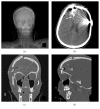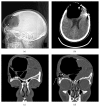Delayed Tension Pneumocephalus following Gunshot Wound to the Head: A Case Report and Review of the Literature
- PMID: 28074167
- PMCID: PMC5198091
- DOI: 10.1155/2016/7534571
Delayed Tension Pneumocephalus following Gunshot Wound to the Head: A Case Report and Review of the Literature
Abstract
Tension pneumocephalus is a rare complication of head trauma and neurosurgical procedures, amongst other causes. It is defined by the combination of intracranial air, increased intracranial pressure, and mass effect. Although it often presents soon after surgery, it can also rarely present in a delayed fashion. We present a case of delayed tension pneumocephalus, occurring approximately 16 weeks after bifrontal craniectomy for a self-inflicted gunshot wound. Following a month of rhinorrhea, postnasal drip, and cough, the patient presented with a sensation of expansion in the area of the right forehead. As tension pneumocephalus is an emergency that can be fatal, this patient was treated expediently and avoided severe neurological deficits. The case recounted here is important as a demonstrative example that tension pneumocephalus does not always follow a defined course immediately after trauma or neurosurgery but rather can develop insidiously without obvious signs.
Conflict of interest statement
The authors declare that there is no conflict of interests regarding the publication of this paper.
Figures



References
-
- Leong K. M., Vijayananthan A., Sia S. F., Waran V. Pneumocephalus: an uncommon finding in trauma. Medical Journal of Malaysia. 2008;63(3):256–258. - PubMed
LinkOut - more resources
Full Text Sources
Other Literature Sources
Research Materials

